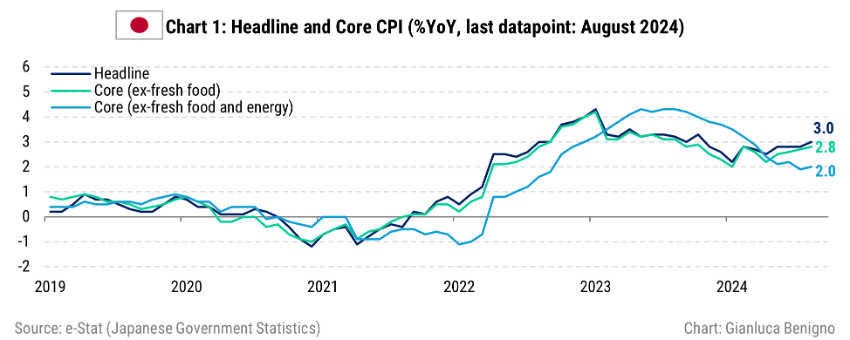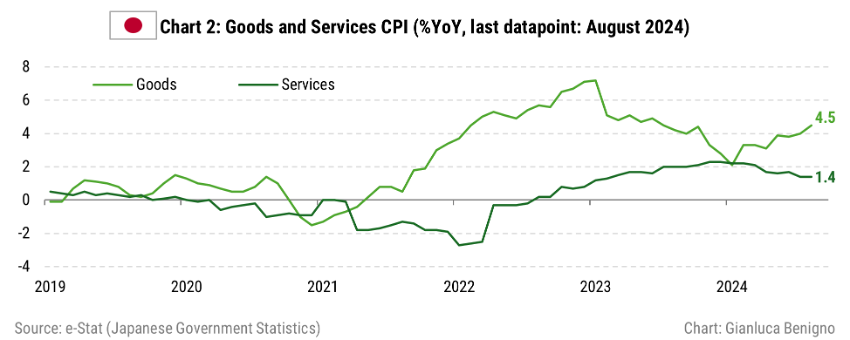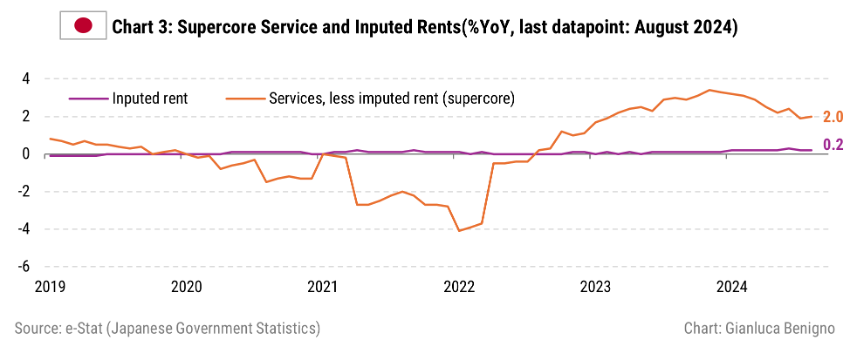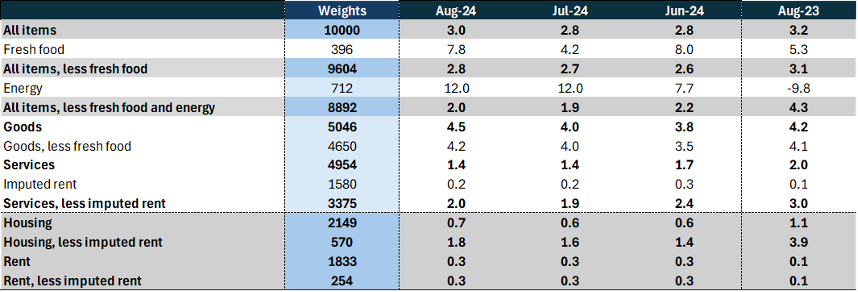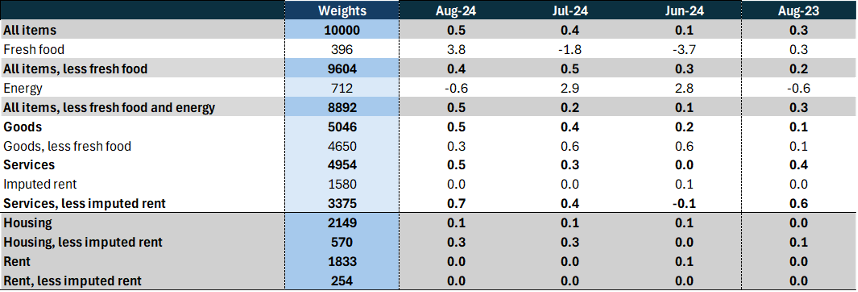Japan August-24 CPI Inflation report
Inflation in line with consensus and with a slow pace of policy normalization
Key takeaways:
Japan's Consumer Price Index (CPI) increased by 3.0% year-on-year (YoY) in August, higher than the 2.8% rise observed in July.
CPI excluding fresh food, the Bank of Japan's preferred measure, rose by 2.8% YoY in August, in line with market expectations of a 2.8% YoY increase, and marginally higher than July’s 2.7% increase.
At the same time, CPI excluding fresh food and energy rose by 2.0% YoY, slightly above the 1.9% YoY increase in July. This core measure highlights that, indeed, most of the upward inflationary pressures that Japan is observing are due to higher energy prices.
Japan's inflation diverges from patterns seen in other advanced economies. It is primarily driven by the goods sector, which rose 4.5% YoY in August (versus 4.0% YoY in July), rather than by the services sector, which saw a 1.4% YoY rise in August, the same figure as in July.
Despite the continued above-target core inflation and the divergence between goods and services inflation, the recent appreciation of the yen from its lows is likely to support a rebalancing of inflation trends, enabling the Bank of Japan to proceed with monetary policy normalization at a gradual pace.
Related Posts
Japan July-24 Inflation Report (previous report);
The Bank of Japan's Put (related post);
Post-FOMC Update: The Fed and the Market Shifts (related post).
Review of the Inflation Release
In August 2024, consumer prices increased by 3.0% year-on-year (YoY), higher than the 2.8% year-on-year reported in July. On a month-to-month basis, prices rose by 0.5%, compared to a 0.4% increase in July.
In terms of core measures, the Bank of Japan tracks two main core inflation metrics (Chart 1): the Consumer Price Index (CPI) excluding fresh food and the CPI excluding both fresh food and energy.
The first measure, which excludes fresh food, increased by 2.8% year-on-year (YoY), in line with market expectations of a 2.8% YoY rise and marginally higher than the 2.7% YoY growth recorded in July. On a month-to-month (MoM) basis, the increase was 0.4%, down from July’s 0.5% increase.
The second core measure, which excludes both fresh food and energy, rose by 2.0% YoY, slightly higher than the 1.9% YoY increase observed in July. On a month-to-month basis, the increase was 0.5%, outpacing July’s 0.2% value. This increase reiterates that energy prices are an important source of upward inflationary prices in Japan.
Additionally, while the services sector is currently the main driver of inflation in many advanced economies Japan’s inflation is predominantly driven by the goods sector (Chart 2). In August, the Goods CPI increased by 4.5% year-on-year (YoY), up from 4.0% YoY in July, while the Services CPI rose by 1.4% YoY, matching July’s figure.
Further emphasizing Japan's unique position, the shelter component (“imputed rents”) of the CPI has remained steady at 0.2% year-on-year (YoY), the same increase as in July. The “imputed rents" measure represents “the rent a person would have to pay to own and occupy a property” which constitutes the largest part of the CPI's housing component and weighs about 15% of the overall CPI. For a detailed breakdown of the housing and rent components in Japan, refer to Tables 1 and 2.
Policy Implications
Inflation trends present mixed signals: while headline inflation and the CPI excluding food remain above target, CPI excluding food and energy, along with service inflation, have eased to levels consistent with the Bank of Japan's inflation target. The primary factor driving headline inflation is the price of goods, which are highly sensitive to exchange rate fluctuations.
With the yen strengthening since its low in early July 2024, the goods inflation component of the CPI is likely to moderate in the final quarter of the year, despite its upward trend since the start of 2024. From a policy standpoint, the Federal Reserve’s rate cut on Wednesday and the narrowing of the corresponding interest rate differential should ease pressure on the yen's depreciation, contributing to lower import price inflation and goods inflation. This would allow the Bank of Japan to maintain a gradual pace of monetary policy normalization, as indicated in recent speeches by members of the Policy Board.
Table 1: CPI by components (% YoY)
Source: e-Stat (Japanese Government Statistics)
Table 2: CPI by components (% MoM)
Source: e-Stat (Japanese Government Statistics)




